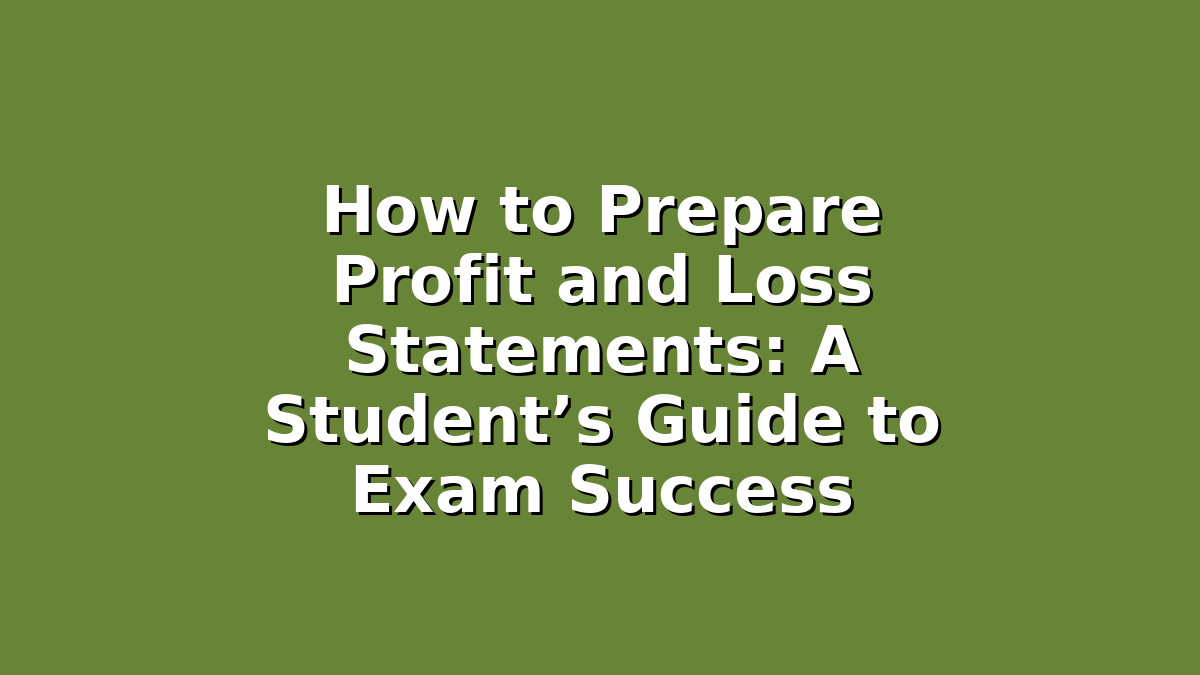Preparing for exams can be stressful, especially when you encounter complex topics like financial statements. One of the essential financial statements you’ll need to understand is the Profit and Loss (P&L) Statement, also known as the Income Statement. This document summarizes a company’s revenues, costs, and expenses during a specific period, showing how profit or loss is generated. For students aiming to master this concept, learning how to prepare and analyze Profit and Loss Statements is crucial not only for exams but also for practical business understanding.
In this article, we’ll break down the process into manageable steps and offer study tips to help you grasp and prepare Profit and Loss Statements confidently. Whether you’re studying accounting, business, or finance, these strategies will support you in achieving exam success.
1. Understand the Components of the Profit and Loss Statement
Before you can prepare a Profit and Loss Statement, it’s essential to understand its main components. These include:
– Revenue (Sales): The total income earned from selling goods or services.
– Cost of Goods Sold (COGS): Direct costs related to producing the goods or services sold.
– Gross Profit: Revenue minus COGS.
– Operating Expenses: Costs incurred during normal business operations, such as rent, salaries, and utilities.
– Operating Profit (EBIT): Gross profit minus operating expenses.
– Other Income and Expenses: Includes interest, taxes, and any non-operating items.
– Net Profit (or Loss): The final profit after all expenses and incomes are accounted for.
Study Tips for Mastering Components:
– Create Flashcards: Write down each component on a flashcard with its definition and formula. Reviewing flashcards regularly helps reinforce your memory.
– Use Real-Life Examples: Try to find a company’s simplified P&L statement online or in textbooks to see how these components appear in practice.
– Draw a Template: Sketch a blank P&L statement template to familiarize yourself with the format and flow of calculations. This visual aid can help you during exams.
Understanding these parts thoroughly forms the foundation for preparing any Profit and Loss Statement.
2. Learn the Step-by-Step Process of Preparing a Profit and Loss Statement
Once you know the components, the next step is to learn how to prepare the statement systematically. Here’s a general approach:
Step 1: Gather Financial Data
Start by collecting the relevant financial information, such as sales figures, inventory data for COGS, and expense records.
Step 2: Calculate Revenue
Sum up all sales or service income during the period.
Step 3: Determine Cost of Goods Sold (COGS)
Use the formula:
COGS = Opening Inventory + Purchases – Closing Inventory
This calculation reflects the actual cost of products sold.
Step 4: Calculate Gross Profit
Gross Profit = Revenue – COGS
Step 5: List Operating Expenses
Include all indirect costs such as salaries, rent, marketing, depreciation, and utilities.
Step 6: Calculate Operating Profit
Operating Profit = Gross Profit – Operating Expenses
Step 7: Account for Other Income and Expenses
Add any other income (like interest earned) and subtract other expenses (such as interest paid and taxes).
Step 8: Determine Net Profit or Loss
Net Profit = Operating Profit + Other Income – Other Expenses
Study Tips for Practicing Preparation:
– Practice with Past Papers: Obtain previous exam questions focusing on P&L statements and practice preparing statements from raw data. Repetition builds confidence.
– Work in Study Groups: Explaining the process to your peers and solving problems together can clarify doubts and strengthen understanding.
– Use Stepwise Notes: Write down each step clearly in your notes, and after practicing a few problems, try to explain the process aloud to yourself.
Working through problems methodically will help you internalize the preparation process and reduce exam anxiety.
3. Analyze and Interpret Profit and Loss Statements for Better Exam Performance
Preparing a Profit and Loss Statement is only one part of the task; being able to analyze and interpret the results is equally important. Exam questions may ask you to comment on profitability, identify trends, or suggest improvements based on the statement.
Key Analytical Points to Focus On:
– Profit Margins: Calculate gross profit margin (Gross Profit ÷ Revenue) and net profit margin (Net Profit ÷ Revenue). Higher margins generally indicate better profitability.
– Expense Management: Analyze whether operating expenses are reasonable or disproportionately high.
– Trends Over Time: Compare statements from different periods to identify improvements or declines.
– Break-even Analysis: Understand how fixed and variable costs affect profitability.
Study Tips for Effective Analysis:
– Create Summary Tables: After preparing a P&L statement, summarize key ratios and figures in tables for quick review.
– Link Theory with Practice: Connect concepts like fixed vs. variable costs with their impact on profits to deepen understanding.
– Practice Explanation Writing: Many exams require written answers. Practice explaining your interpretations clearly and concisely to develop this skill.
By mastering analysis, you not only prepare well for exams but also gain skills relevant for real-world business decision-making.
Conclusion
Preparing Profit and Loss Statements can seem daunting at first, but breaking the process into clear steps and practicing regularly will make it manageable and even enjoyable. Understanding the components, following a step-by-step preparation process, and learning to analyze the results are the keys to exam success. Remember to use study aids like flashcards, practice problems, and group discussions. Most importantly, stay positive and give yourself time to absorb the material. With consistent effort and a strategic approach, you’ll be well-prepared to tackle Profit and Loss Statements confidently in your exams.
Good luck, and happy studying!

Responses